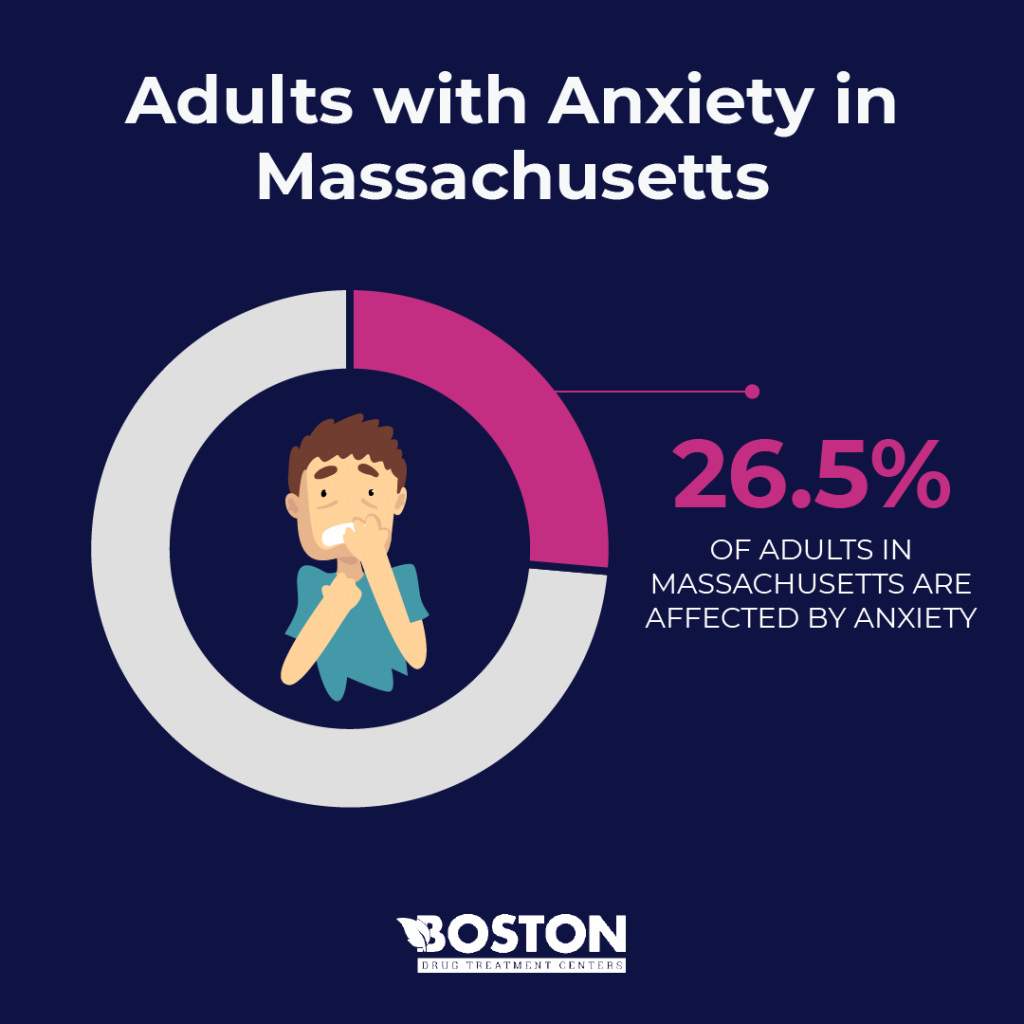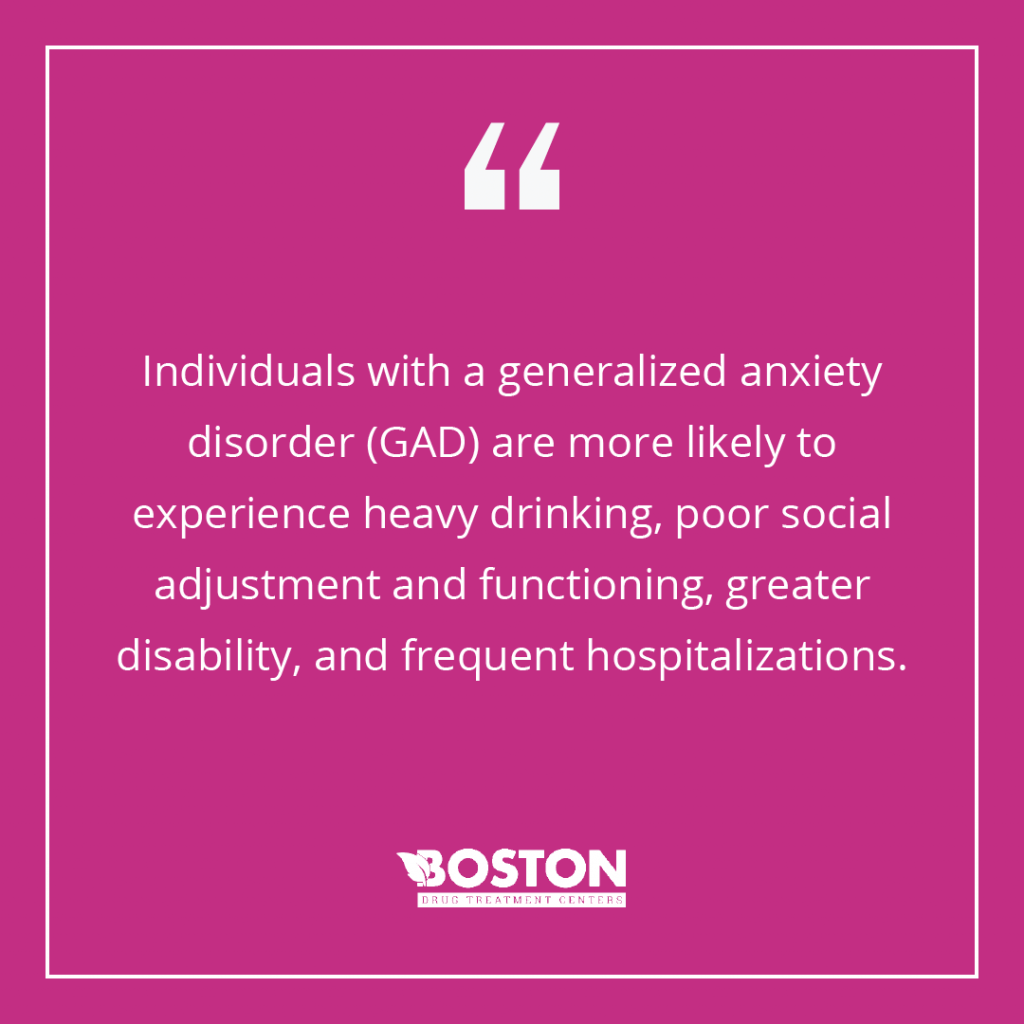Anxiety & Co-Occurring Substance Abuse
One in 13 people around the world experience an anxiety disorder but only a third seek treatment.1 According to a 2021 U.S. Census Bureau survey, during the COVID-19 pandemic 26.5% of adults living in Massachusetts reported experiencing symptoms of anxiety.2
Substance abuse and anxiety frequently occur together. For example, addiction and posttraumatic stress disorder are closely linked, and individuals with substance use disorders (SUD) have a higher likelihood of co-occurring PTSD.3 This combination can significantly interfere with treatment outcomes, leading to more severe symptoms, early treatment drop-out, and a greater risk for relapse.3
Anxiety does not go away on its own. Without treatment, symptoms usually worsen over time. If you struggle with co-occurring conditions, finding a dual diagnosis treatment program in Boston can dramatically improve your recovery.

Types of Anxiety Disorders
Drug and alcohol addiction often co-occur with mental health conditions like anxiety. Anxiety disorders are characterized by ongoing fear and worry on most days for at least six months.4 Identifying which type of anxiety disorder you are experiencing is the first step in the recovery process.
Panic Disorder
Individuals with panic disorder suffer from frequent panic attacks—sudden surges of intense fear or emotional discomfort. Panic attacks can be mild or extreme but often get worse without treatment.
Signs and symptoms of panic attacks:5
Some people also experience neck soreness, ringing in the ears, uncontrolled screaming or crying episodes.
Generalized Anxiety Disorder

- Restlessness, keyed up, or on edge
- Easily fatigued
- Difficulty concentrating
- Irritable
- Tense muscles
- Disturbed sleep
Specific Phobia Disorder
- Active avoidance of triggering objects or situations
- Fear or anxiety that is disproportionate to the actual potential danger
- Persistent anxiety lasting 6 or more months
- Anxiety that causes clinically significant distress in social, occupational, or other major life areas
Separation Anxiety Disorder
Individuals with separation anxiety disorder experience excessive fear or anxiety when separated from home or an attachment figure. In many people, anxiety occurs even when an absence is merely anticipated. Separation is a normal stage of childhood development, but parental overprotection and intrusiveness may be associated with a higher prevalence of this disorder.5
Signs and symptoms of separation anxiety disorder:5
- Worrying about losing an attachment figure
- Feeling distress when anticipating or experiencing separation from home or an attachment figure
- Worrying about getting lost, being kidnapped, having an accident, resulting in becoming separated from an attachment figure
- Feeling reluctant or refusing to leave home due to fear of separation
- Fear of being alone
- Worrying that harm will come to an attachment figure (i.e., illness, injury, disasters, or death)
- Feeling reluctant or refusing to sleep away from attachment figure
- Repeated nightmares about separation
- Physical symptoms (i.e., headaches, gastric distress, nausea, vomiting) when separated from attachment figures
Social Anxiety Disorder (Social Phobia)
Social anxiety disorder (social phobia) involves the fear of being negatively judged or scrutinized by others, especially in social situations. Technology can also trigger social anxiety. With the increasing use of video-based software, technostress has become more common.9
Triggers associated with social anxiety disorder:5

- Having a conversation
- Meeting new people
- Being watched while eating or drinking
- Performing or speaking in front of others
The central theme of SAD is the fear of being embarrassed, humiliated, or rejected. Individuals with this disorder will often self-isolate, which leaves them at a greater risk for depression.
Many anxiety-related disorders share common characteristics. For example, disruptions in emotional regulation appear to play a significant role in both PTSD and SUD.3 Similarly, obsessive compulsive disorder (OCD) and PTSD often have overlapping signs and symptoms, however they are classified as trauma-and-stressor-related disorders rather than anxiety disorders.
Why Anxiety and Substance Addiction Co-Occur
Conversely, people who misuse substances often develop secondary anxiety due to neurological changes in the brain.10 This can seriously complicate the treatment and recovery process because symptoms of anxiety may also worsen during withdrawal.
Causes of Anxiety and Substance Abuse
While there is a strong association between anxiety and substance abuse, the cause isn’t as clear. Anxiety disorders are often diagnosed at a younger age than SUDs, but that alone does not mean anxiety disorders cause substance abuse.11 The drivers behind anxiety and substance abuse appear to be multifactorial.
Risk factors for co-occurring anxiety and substance abuse include:12
- Genetics: Stress and trauma can be passed down through generations. People who have close family members with anxiety disorders are more vulnerable to developing a related condition.
- Mental Disorders: People who have pre-existing mental disorders are more likely to suffer from anxiety disorders.
- Early childhood trauma: Exposure to traumatic experiences, such as child abuse, violence, or sexual trauma, increases the risk of anxiety in adulthood.
- Substance Use: Substance misuse can permanently alter brain function, increasing the risk of developing other mental disorders.
- Prolonged stress: People who are exposed to stress for long periods of time are at a higher risk for anxiety.
How Anxiety and Addiction Affect Each Other
Anxiety and addiction often create a cyclical pattern, and individuals who live with the conditions face constantly changing moods and anxiety levels. For this reason, diagnosing substance use disorder when anxiety disorder is also present can be difficult.6 Determining whether a person’s anxiety symptoms are caused by the substance itself or due to withdrawal from the substance is not always clear.
Nearly half of individuals who live with substance use disorders also experience a co-occurring mental disorder, such as anxiety.13 Anxiety and substance use disorders also occur at higher rates in individuals with bipolar II disorder than in the general population.5 For example, 75% of patients with bipolar II disorder also have anxiety.5
Early treatment is crucial because sustained anxiety may lead to higher rates of impulsivity, longer duration of illness, higher suicide rates, and poorer response to treatment.5 When a substance use disorder is present, it can also decrease the recovery rate of GAD.14
Dual Diagnosis Treatment Programs in Boston, MA
When substance use disorder co-occurs with an anxiety disorder, it’s known as a dual diagnosis.12
The World Health Organization first used the term “dual diagnosis” in the 1990s to describe the co-occurrence of substance use disorder with other mental illnesses.6 The term “co-occurring disorder” is used more frequently today.
Integrated treatments address multiple conditions simultaneously.11 This integrated treatment approach includes both pharmacological and psychotherapeutic elements.6 Inadequate treatment of one or both disorders can increase the risk of relapse, so treating co-occurring conditions in tandem is a more holistic approach that improves outcomes.
For the best possible outcomes, your dual diagnosis treatment program should be tailored to your specific needs. Before recommending a treatment, your specialist will assess the following during your intake evaluation:
- Medical history
- Previous treatment experiences
- Prior withdrawal symptoms
- Past response to medications
- Substance misuse history
- Mental health history
- Family history
The following approaches may be included in your dual diagnosis treatment program:
- Medications for anxiety: Anti-anxiety medications reduce the number and intensity of panic attacks.4 The most common anti-anxiety medications include:4
- Benzodiazepines rapidly reduce anxiety symptoms but can lead to dependence.
- Antidepressants alter the way your brain uses or responds to chemicals and improves anxiety symptoms.
- Beta-blockers alleviate physical symptoms associated with panic attacks (i.e., rapid heart rate, shaking, shortness of breath, etc.).
- Medications for addiction: Naltrexone, acamprosate, and disulfiram are commonly used to reduce alcohol use, while methadone and buprenorphine are frequently used to treat opiate use disorders.15
- Therapies for anxiety and addiction: Cognitive behavioral therapy shows promising results in treating dual diagnoses like PTSD, anxiety, and substance dependence.14 Programs that focus on managing emotional regulation may also lead to better recovery outcomes.3
If you or someone you love struggles with anxiety and co-occurring substance abuse, our recovery support specialists at Boston Drug Treatment Centers can guide you toward the help you need. Call our helpline today at 617-517-6448.
Frequently Asked Questions About Anxiety & Co-Occurring Substance Abuse
Anxiety does not directly cause substance misuse, but some people use substances to self-medicate or reduce symptoms of anxiety.
Can Anxiety be Cured?
There is no cure for anxiety, but it can be treated and managed successfully.
Does Substance Abuse Cause Anxiety?
Substance misuse can lead to increased anxiety levels in some people, especially during withdrawal. For this reason, it’s important to seek help from specialists who have training in dual diagnosis treatment.
Resources
- Anxiety & Depression Association of America. (Accessed 10/5/2021). What Is Anxiety?
- Kaiser Family Foundation. (2020). Analysis of U.S. Census Bureau, Household Pulse Survey.
- Hien, D. A., Lopez-Castro, T., Papini, S., Gorman, B., & Ruglass, L. M. (2017). Emotion dysregulation moderates the effect of cognitive behavior therapy with prolonged exposure for co-occurring PTSD and substance use disorders. Journal of anxiety disorders, 52, 53–61.
- National Institute of Mental Health. (July 2018). Anxiety Disorders.
- American Psychiatric Association. DSM-5. (2013). Diagnostic and statistical manual of mental disorders (5th ed.).
- Iqbal, M. N., Levin, C. J., & Levin, F. R. (2019). Treatment for Substance Use Disorder with Co-Occurring Mental Illness. Focus (American Psychiatric Publishing), 17(2), 88–97.
- Burns, L., Teesson, M., & O’Neill, K. (2005). The impact of comorbid anxiety and depression on alcohol treatment outcomes. Addiction (Abingdon, England), 100(6), 787–796.
- National Institute of Mental Health. (Accessed 10/5/2021). Specific Phobia.
- Daruwala, Neil. (2020). Generation Lockdown: Exploring possible predictors of technology phobia during the Coronavirus self-isolation period Generation Lockdown: Exploring possible predictors of technology phobia during the Coronavirus self-isolation period. Aloma: Revista de Psicologia, Ciències de l’Educació i de l’Esport. 38.
- Robinson, J., Sareen, J., Cox, B. J., & Bolton, J. M. (2011). Role of self-medication in the development of comorbid anxiety and substance use disorders: a longitudinal investigation. Archives of general psychiatry, 68(8), 800–807.
- McHugh R. K. (2015). Treatment of co-occurring anxiety disorders and substance use disorders. Harvard review of psychiatry, 23(2), 99–111.
- American Addiction Centers. (February 2020). Treating Addiction with Anxiety Disorders.
- National Institute for Mental Health. (March 2021). Substance Use and Co-Occurring Mental Disorders.
- Smith, J. P., & Book, S. W. (2008). Anxiety and Substance Use Disorders: A Review. The Psychiatric times, 25(10), 19–23.
- Douaihy, A. B., Kelly, T. M., & Sullivan, C. (2013). Medications for substance use disorders. Social work in public health, 28(3-4), 264–278.
